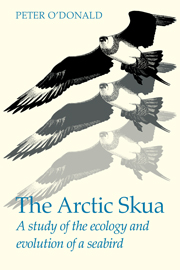Book contents
- Frontmatter
- Contents
- List of figures
- List of tables
- Preface
- 1 The Arctic Skuas of Fair Isle
- 2 Numbers and distribution
- 3 Feeding behaviour and ecology
- 4 Breeding ecology
- 5 Genetics
- 6 Demography and selection
- 7 Sexual behaviour
- 8 Sexual selection
- 9 Genetic models of sexual selection in birds
- 10 Mating preferences of the Arctic Skua
- 11 Conclusions
- Appendix A Rates of increase of bird populations
- Appendix B Analysis of variance of a 2 × r table with unequal numbers of observations
- Appendix C Statistical analysis of assortative and disassortative mating in polymorphic birds
- References
- Index
9 - Genetic models of sexual selection in birds
Published online by Cambridge University Press: 21 May 2010
- Frontmatter
- Contents
- List of figures
- List of tables
- Preface
- 1 The Arctic Skuas of Fair Isle
- 2 Numbers and distribution
- 3 Feeding behaviour and ecology
- 4 Breeding ecology
- 5 Genetics
- 6 Demography and selection
- 7 Sexual behaviour
- 8 Sexual selection
- 9 Genetic models of sexual selection in birds
- 10 Mating preferences of the Arctic Skua
- 11 Conclusions
- Appendix A Rates of increase of bird populations
- Appendix B Analysis of variance of a 2 × r table with unequal numbers of observations
- Appendix C Statistical analysis of assortative and disassortative mating in polymorphic birds
- References
- Index
Summary
Female preferences and male competition in monogamous birds
Let us suppose that some males possess a genetic characteristic that can increase female arousal. Some females, responding more rapidly to these males, thus mate with them preferentially. Other females, however, show no preferences: they just choose any male at random. To construct a theoretical model of the sequence of matings, I assume that groups of females come into breeding condition during successive intervals of the breeding season. They choose their mates from the available pool of unmated males. This pool decreases, of course, as each successive group of females choose their mates. Later females may not be able to mate with the males they prefer because none may be left in the pool.
In monogamous species, the sequence of matings is clearly important in determining what choices can be made. This applies to the matings taking place within a particular group of individuals. Females with particular preferences might choose their mates before, at the same time as, or after the females who mate at random. If preferential matings come first, more females will be able to mate with the males they prefer. But if the random matings come first, some preferred males will already have been chosen when the preferential matings take place: females will then have less opportunity to express their preferences.
The behavioural mechanism of mate selection will presumably determine the sequence of preferential and random matings.
- Type
- Chapter
- Information
- The Arctic SkuaA study of the ecology and evolution of a seabird, pp. 210 - 243Publisher: Cambridge University PressPrint publication year: 1983



